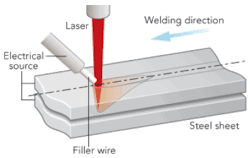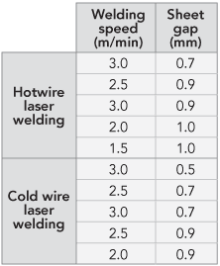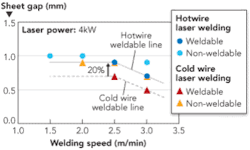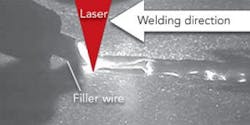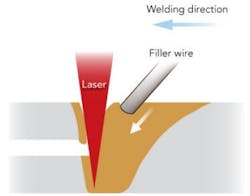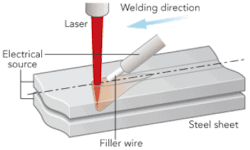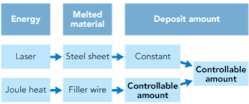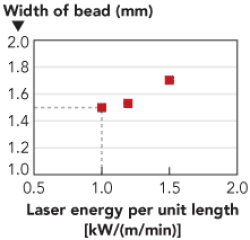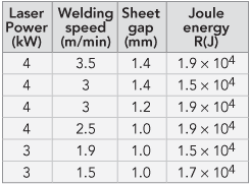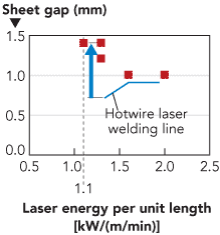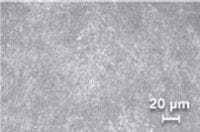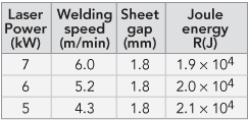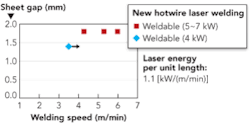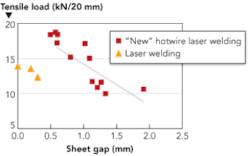A new technology using a hotwire system can extend gap tolerance of laser welding
By Yoichiro Kitahara, Mitsugi Fukahori, Chikara Tanaka, Kenji Shinozaki, and
Motomichi Yamamoto
Automobile manufacturers are pursuing development of vehicles with excellent fuel economy considering environmental sustainability, and lightweight technologies are important in that respect. Currently, laser welding technology is applied to continuous joining, which can contribute to lightweight bodies, however, it can be difficult to hold weld quality because welding defects often occur at the lap joint of thin steel sheets with large gaps [1-3].
In addition, high productivity and high welding speed are expected in order to make the most of the energy because of the large investment in the laser facilities. For instance, it was reported that laser-arc hybrid welding technology could weld joints with gaps of about 100% the upper sheet thickness [1]; however, burn-through defects might occur, owing to high arc current in case of larger gap.
Evaluation of gap tolerance
Hotwire technology (hereafter hotwire laser welding) has been studied as a means to increase metal deposit amounts and expand gap tolerance without too much heat input to the steel sheet. The study results of this new welding technology, which is completely different from existing hotwire laser welding, has been reported [4] as follows.
High strength steel sheets (TABLE 1) were used and a lap joint was made up by two sheets (FIGURE 1).
The standard of filler wire was JIS Z 3312 YGW18 (φ 1.0) or JIS Z 3312 YGW23 (φ1.2). The structure of the equipment is shown in FIGURE 2. The filler wire was irradiated by a 4kW fiber laser, and hotwire laser welding or cold wire laser welding was used depending on whether it was with or without joule heat.
Test conditions are shown at TABLE 2. Joule heat was controlled not to melt the hotwire.
The test results are shown in FIGURE 3.
The gap tolerance of hotwire laser welding expanded by 20%, compared to cold wire laser welding, by increasing a deposit amount (25% increase at 3.0 m/min welding). However, the gap tolerance was as long as 90% of the upper sheet that is 1mm thick. Moreover, at the cross section of hotwire laser welding, no under-fill was observed, and the gap was filled with wire properly. Thus, the joint was considered faultless (FIGURE 4).
The laser welding process was observed to understand the welding phenomenon in detail. FIGURE 5 shows the cold wire laser welding phenomenon, recorded with a high-speed camera: the laser irradiated and melted a part of the filler, irradiated a part of the sheet metal, and formed a molten pool behind the irradiation part. Consequently, we believe that the same phenomenon would occur in the case of hotwire laser welding, and electricity would be cut between filler wire and sheet metal so that joule heat would become ineffective.
Moreover, when the gap became larger, melted metal often remained so that a welding joint was not formed. FIGURE 6 shows the cross section of the welding defect, and we considered that it was a result of a lack of deposit amount and surface tension of melt metal.
New process study
In the preceding section, two issues were clarified. One is ineffective joule heat because of little electricity through melted wire and molten pool. The other is small gap tolerance because of the melted metal staying on the upper sheet. Therefore, new welding concepts to expand the gap tolerance were considered and these conditions were studied:
1) To avoid laser irradiation for filler wire, laser melts sheet metal only, and joule heating melts filler wire only.
2) To prevent melted metal from staying on the upper sheet, force the melted metal to the lower sheet metal.
First, satisfying condition 1), the position of the filler wire is changed into the molten pool made by the laser, which is shown in FIGURE 7, then the filler wire can be heated by electricity without laser irradiation.
Next, the heated filler wire that is put into the molten pool moves the melted sheet metal to the lower sheet. FIGURE 8 shows the equipment.
FIGURE 9 shows the energy flow of the new process related to the deposit amount. In the new process, we can study the laser condition and hotwire condition individually.
New process
Materials used were the same as previous section. We chose laser energy of 3.4 kW laser power for the concept study and ~5 to 7 kW for the high speed welding study.
Laser welding conditions were adjusted so that the laser beam would penetrate the metal sheets and the spot diameter was set to make a 1.2 mm bead width, substitute index of molten pool size, and to form bead on lower sheet metal as well. In addition, the heat input of the laser (laser power/ welding speed) was used in this study as a parameter. FIGURE 10 shows that heat input of the laser correlates with bead width. Hence, the heat input of laser was changed within ~1.0 to 2.0 kW/(m/min), and it was proven that bead width becomes more than 1.5 mm when heat input of the laser is more than 1.0 kW/(m/min).
Hotwire condition study
The hotwire temperature was set just below the ferric melt point at contact to the molten pool. Hence, the rough heat value was estimated according to the following equation for general condition definition. (Resistance of the wire is assumed constant because of rough estimation.)
Q=RI2t
where
Q = heat value (J)
R = resistance of wire (Ω)
I = current value (A) and
t = electric time (sec)
FIGURE 11 shows the weld bead at the appropriate heat value of the hotwire. Filler wire was well melted and a uniform weld bead was formed.
FIGURE 12 shows the weld bead at insufficient heat value of hotwire; the filler wire was not completely melted. Consequently, the appropriate hotwire condition is defined as more than 1.1×104R (J).
Welding results
TABLE 3 shows welding test conditions of laser and hotwire, adjusted with the condition studies as stated above.
FIGURE 13 shows the test results organized by the heat input of laser and gap tolerance. All conditions were able to make good welds, and the deposit amount per unit length increase by 150% compared with the past hotwire laser welding; because of this, gap tolerance is extended up to 140% of upper sheet.
FIGURE 14 shows the cross section of new hotwire laser welding, and there was no underfill at the weld bead.
FIGURE 15 shows the metallic structure at the weld bead. Martensite was observed in the weld metal, so it is thought that filler wire was melted after moving into the molten pool.
High speed welding study
It was proven that the new hotwire laser concept can make good welds because it can control laser and filler wire conditions individually. Thus, it was assumed that the following conditions can produce high speed welding:
1) making sure of appropriate heat input by laser, which makes good welding (section 3.2.2),
2) making sure of electricity condition, which melts filler wire moderately (section 3.2.3), and
3) estimating laser and wire conditions for high speed welding.
Welding conditions were determined with constant heat input of laser based on conditions 1 and 2 above (TABLE 4).
And in this study, gap tolerance was kept at 1.8 mm at each welding speed because filler wire feeding speed was restricted. Consequently, speedier welding was achieved with 1.8 mm gap tolerance than 4 kW laser output (FIGURE 16).
There were no under fills and a good joint was made (FIGURE 17). Moreover, welding was possible at all conditions in the table.
It is considered that the new process can be applied to larger gap tolerance with higher wire feeding speed because welding speed depends on the laser power that melts sheet metal.
Welding quality
Tensile strength of new hotwire laser welding was compared with laser welding (FIGURE 18). The tensile strength was higher than laser welding tolerance at small gap but that became lower according to increasing gap tolerance. The reason is considered to be bending moment work on joining part when large gap exists.
Summary
A new process with a hotwire system was developed as a technology that can extend gap tolerance of laser welding, and the following were clarified:
1) New process to insert hotwire to molten pool made by laser irradiation was developed.
2) New process can weld at the gap as about 180% as upper sheet thickness.
3) Laser and filler wire conditions can be adjusted individually so the application is facile even if sheet metal thickness changes.
4) Tensile strength is decreasing according to increasing gap tolerance. The reason is considered to be bending moment work on joining part when large gap exists.
References
1. M. Ono, Y. Shinbo, A. Yoshitake, and M. Ohmura, "Laser-arc hybrid welding of thin steel sheets," Q. J. JWS, 21-4 (2003), 515-521.
2. K. Mori, "Laser welding application of car body in Nissan," JSAE 20037144, SAE2003-01-2864.
3. K. Shinozaki, M. Yamamoto, K. Kadoi, Y. Katakami, and T. Ozaki, "Gap effect on defect formation during laser lap welding for galvannealed steel sheet," Prep.Nat.Meet. JWS, No. 85, 154-155.
4. Y. Kitahara, C. Tanaka, K. Ishida, M. Fukahori, K. Shinozaki, and M. Yamamoto, "Development of hotwire laser welding for lap joint with large gap," 2010 JSAE Annual Congress (Spring) Proceedings, No. 33-10, 166-20105252, Extracted issue from Society of Automotive Engineers of Japan Inc.
Yoichiro Kitahara ([email protected]) and Mitsugi Fukahori are with Mazda Motor Corp., Technical Research Center, in Hiroshima. Kenji Shinozaki and Motomichi Yamamoto are with Hiroshima University, Hiroshima, Japan.



